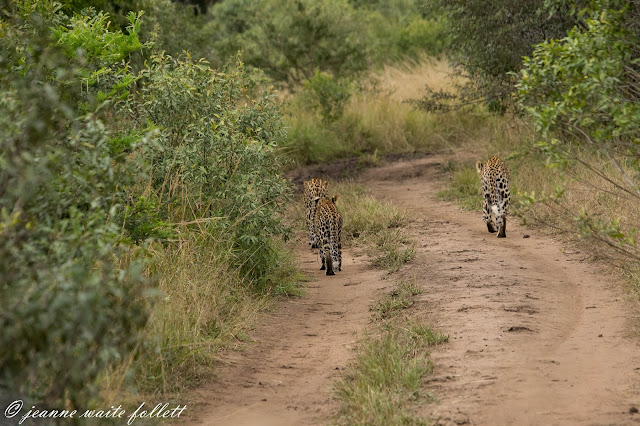We are on safari in Phinda Private Game Reserve, located near the eastern coast of South Africa. It is June, and winter here, but not as cold as our last camp that adjoined the northern edge of Kruger National Park. Blankets are available, but no hot water bottles.
 |
| Look above Durban on the eastern coast. |
As the map shows, we are in the South African state of Kwazulu-Natal.
On this particular day, we come upon a leopard and her cubs walking down a road in the Phinda reserve.
We follow slowly, giving them plenty of room. They appear utterly unconcerned about our presence, and never look back. Eventually, they move into the bushveld.
We follow. Unlike the national parks (and some private reserves), the safari vehicles are allowed to go off-road.
 |
| Pausing for a drink. |
The vehicle climbs a steep bank, dodging trees and bushes and finally reaching the thicket shown below. Another safari vehicle is there.
One of the leopard cubs is in that thicket, and Amy and Telusi move us around, trying to find the optimal spot for photographs.
And there he is.
He often looks up into the branches, obviously thinking he should climb. But, his mother has left him a lesson to learn and he is reluctant to abandon it.
And then we see his lesson. The mother caught and killed a young nyala (antelope) and left him with it while she and the other cub went away.
Up the tree he goes.
Then, he's down again. He watches the vehicles.
He toys with the carcass, rolling around on the ground and pawing at it.
Instinct takes over and he moves the nyala to a darker place in the thicket. By doing this, he strengthens the neck and shoulder muscles he will need to survive on his own.
That took some effort. He checks once again for his mother and sibling.
He practices grabbing the nyala by the neck, but his jaws aren't big enough yet to get a good grasp. Tht is how leopards kill their prey--holding the animal by the neck and suffocating it.
And then, for a brief moment, predator and prey are locked in a deadly embrace.
Leopards tend to carry their prey into the high branches of a tree to protect it from scavengers that would steal it from them, in particular, lions and hyenas.
His indecision is palpable. He isn't strong enough to lift the nyala, though when he is full grown, he will be able to carry a prey weighing more than himself up a tree.
What to do? What to do?
Maybe I can practice jumping on it from a branch....
Again, he opts to play rather than get down to business.
.
(Look at those claws!)
Gotcha!
Mom? Where are you? You forgot to open it.
And then, he gets the idea and starts to bite the carcass in its soft underparts. That's when we leave.







































Good time to leave ... watching the young leopard playing with the nyala that has been captured is one thing, but would not want to watch or see pictures of the nyala being eaten. The maps are great for being able to orient to exactly where you were. Life in the jungle. Fascinating to be IN that world for awhile. Always appreciate the journey with you through your posts. Smiles and thank you for this latest installment! Patti and Cap
ReplyDeleteI'd forgotten their June is their winter. Of course. I don't think you want to be there during their summer which would be in December / January. Where did the maps come from? Did you photograph them and then post the photos of the maps. I have now regained the use of Google Maps on my dot.net website but NOT on my Google website blogspot. Go figure. Life out there in the wild surely is dog-eat-dog. Oh my. Like Patti I too can do without the further gory details of dinner. Thanks for all the work on these Posts. Cap in Irkutsk and Patti home in
ReplyDeleteAnchorge.